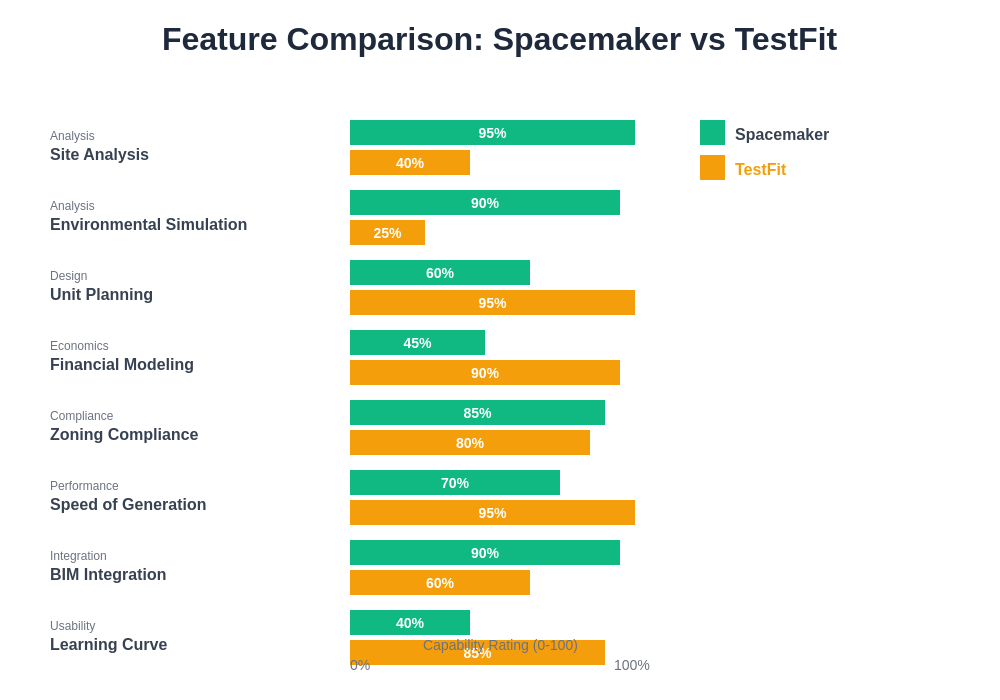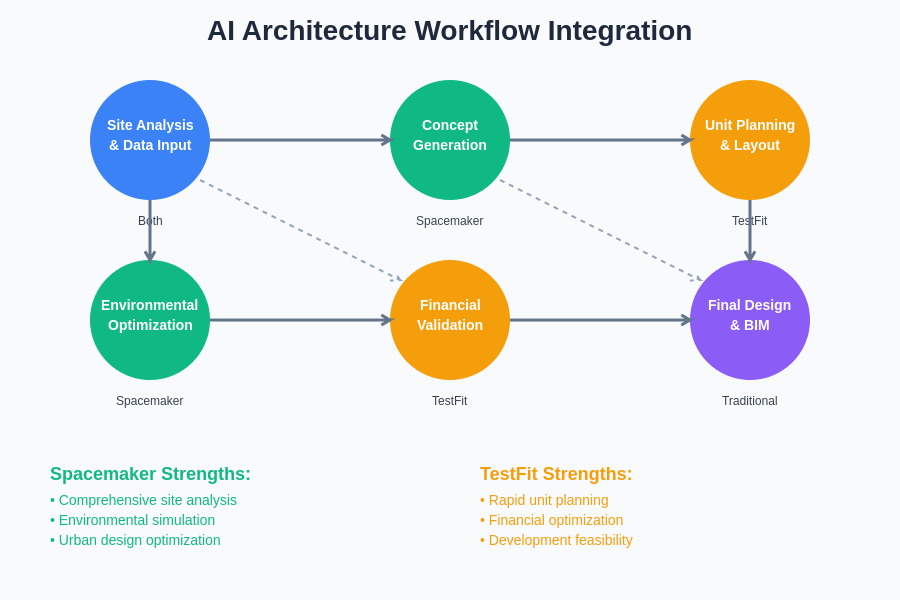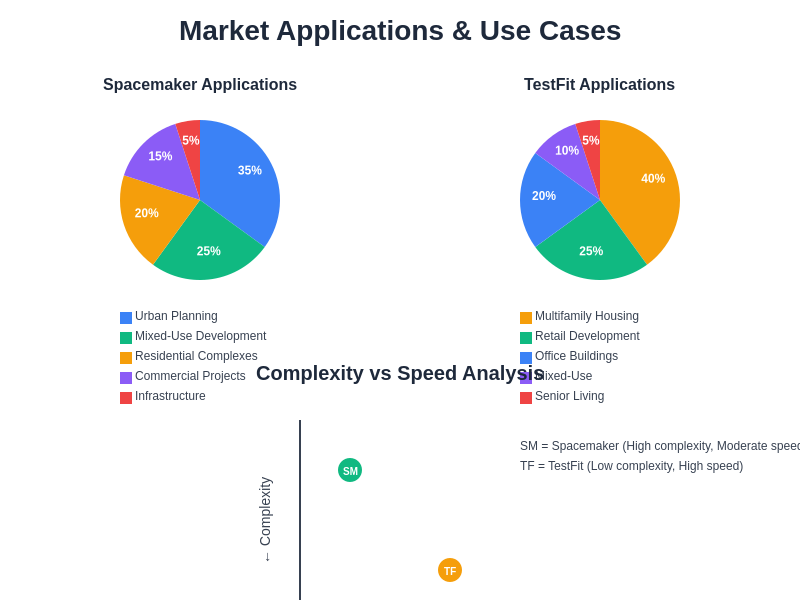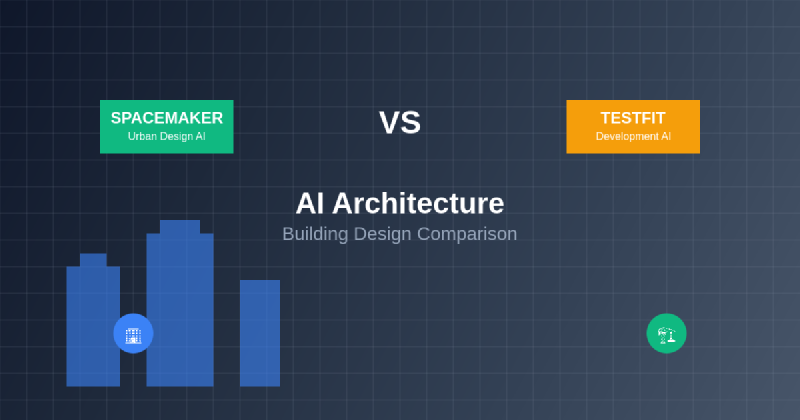The architectural industry stands at the precipice of a technological revolution, where artificial intelligence is fundamentally transforming how buildings are conceived, designed, and optimized. Among the pioneering platforms leading this transformation, Spacemaker and TestFit have emerged as dominant forces, each offering unique approaches to AI-powered building design that promise to revolutionize traditional architectural workflows. These sophisticated platforms represent the convergence of machine learning algorithms, advanced computational design principles, and practical architectural expertise, creating tools that can generate, analyze, and optimize building designs at unprecedented speed and precision.
Explore the latest AI innovations in architecture to stay current with emerging technologies that are reshaping how we approach building design and urban planning. The integration of artificial intelligence into architectural practice represents more than just technological advancement; it embodies a fundamental shift toward data-driven design decisions that can optimize multiple variables simultaneously while maintaining aesthetic and functional integrity.
Understanding AI-Powered Building Design
The emergence of AI-powered building design platforms has created new paradigms for architectural practice, where traditional design processes are augmented and accelerated through intelligent automation and optimization algorithms. These systems leverage machine learning to analyze vast datasets of successful building designs, zoning requirements, environmental factors, and user preferences to generate optimized solutions that balance multiple competing objectives. The sophistication of these platforms lies not merely in their ability to generate designs, but in their capacity to understand complex relationships between spatial requirements, regulatory constraints, economic considerations, and environmental performance metrics.
Modern AI building design tools represent a convergence of multiple technological disciplines, including computer vision for site analysis, natural language processing for requirement interpretation, optimization algorithms for performance enhancement, and generative modeling for creative solution generation. This interdisciplinary approach enables architects and developers to explore design possibilities that would be impossible or prohibitively time-consuming to investigate through traditional methods, while ensuring that generated solutions remain practical, buildable, and economically viable.
Spacemaker: Comprehensive Urban Design Intelligence
Spacemaker, acquired by Autodesk in 2020, represents a sophisticated approach to AI-powered building design that emphasizes comprehensive site analysis and optimization across multiple performance metrics. The platform’s strength lies in its ability to process complex urban environments and generate design solutions that optimize for factors including daylight access, wind patterns, noise levels, parking requirements, and regulatory compliance. Spacemaker’s algorithms can analyze thousands of design variations simultaneously, evaluating each against predefined criteria to identify optimal solutions that balance competing objectives while maintaining design quality and regulatory compliance.
The platform’s approach to generative design extends beyond simple massing studies to incorporate detailed analysis of environmental conditions, circulation patterns, and programmatic requirements. Spacemaker’s AI engine can process site constraints including topography, existing structures, utility locations, and zoning regulations to generate designs that are not only aesthetically compelling but also practically implementable. This comprehensive analysis capability makes Spacemaker particularly valuable for complex urban projects where multiple stakeholders, regulatory requirements, and environmental factors must be carefully balanced to achieve successful outcomes.
Experience advanced AI design tools like Claude for enhanced analytical capabilities that can support complex architectural decision-making processes and provide insights into design optimization strategies. The integration of multiple AI systems creates a powerful ecosystem for architectural innovation that extends beyond individual platform capabilities.
TestFit: Real Estate Development Optimization
TestFit approaches AI-powered building design from a distinctly different perspective, focusing primarily on real estate development optimization and early-stage feasibility analysis. The platform excels at rapidly generating and evaluating building configurations that maximize development potential while adhering to zoning constraints and market requirements. TestFit’s algorithms are specifically tuned for multi-family residential, commercial, and mixed-use developments, providing developers and architects with immediate feedback on unit counts, parking ratios, floor area calculations, and financial projections.
The platform’s strength lies in its ability to generate hundreds of design variations within minutes, each optimized for different market conditions and development scenarios. TestFit’s AI engine can automatically adjust unit mixes, parking configurations, and building orientations to maximize rental income, optimize construction costs, and ensure regulatory compliance. This rapid iteration capability enables development teams to explore multiple design scenarios early in the project timeline, identifying optimal solutions before significant resources are invested in detailed design development.
Feature Comparison and Capabilities Analysis
The fundamental differences between Spacemaker and TestFit become apparent when examining their core feature sets and intended use cases. Spacemaker offers comprehensive site analysis capabilities including solar studies, wind analysis, noise mapping, and environmental impact assessment, making it ideal for projects where environmental performance and urban integration are primary concerns. The platform’s sophisticated modeling capabilities can account for complex site conditions, existing infrastructure, and regulatory requirements while generating design solutions that optimize multiple performance metrics simultaneously.

TestFit, conversely, focuses on economic optimization and development feasibility, providing tools specifically designed for real estate development scenarios. The platform excels at unit planning, parking design, and financial analysis, offering immediate feedback on development metrics including gross rental income, construction costs, and return on investment calculations. TestFit’s algorithms are specifically tuned for common development typologies, enabling rapid generation of feasible design solutions that meet market requirements and regulatory constraints.
Design Process Integration and Workflow Enhancement
The integration of AI design tools into traditional architectural workflows requires careful consideration of existing processes, team capabilities, and project requirements. Spacemaker integrates seamlessly with established BIM platforms including Revit and SketchUp, enabling architects to import existing models and leverage AI optimization within familiar design environments. This integration capability allows design teams to incorporate AI-generated insights into traditional design processes without requiring wholesale changes to established workflows or software ecosystems.
TestFit’s approach to workflow integration emphasizes speed and accessibility, providing web-based tools that can be used by diverse team members including architects, developers, and financial analysts. The platform’s simplified interface enables rapid concept exploration without requiring extensive training or specialized software knowledge. This accessibility makes TestFit particularly valuable for early-stage design development where multiple stakeholders need to collaborate on feasibility analysis and concept refinement.

The integration of AI architecture tools into professional practice requires careful orchestration of multiple platforms and traditional design processes. The workflow diagram above illustrates how both Spacemaker and TestFit can complement each other throughout different phases of the design process, with each platform contributing its unique strengths at optimal points in the development timeline.
Performance Optimization and Analysis Capabilities
The analytical capabilities of both platforms extend far beyond simple geometry generation to encompass comprehensive performance evaluation across multiple domains. Spacemaker’s environmental analysis tools can evaluate designs for energy performance, daylight quality, wind comfort, and noise exposure, providing quantitative metrics that support evidence-based design decisions. These analysis capabilities enable architects to optimize building performance while maintaining design quality and aesthetic integrity.
TestFit’s performance optimization focuses primarily on economic metrics including development costs, rental income potential, and market competitiveness. The platform can automatically adjust design parameters to maximize financial performance while ensuring compliance with zoning requirements and market expectations. This economic focus makes TestFit particularly valuable for development projects where financial viability is the primary optimization objective.
Discover comprehensive AI research capabilities with Perplexity to support in-depth analysis of building performance metrics and market conditions that inform AI-driven design decisions. The combination of multiple AI tools creates a comprehensive analytical framework for complex architectural projects.
User Experience and Learning Curve Considerations
The user experience design of both platforms reflects their intended audiences and use cases, with significant implications for adoption and effectiveness within different organizational contexts. Spacemaker’s interface emphasizes comprehensive analysis and detailed parameter control, requiring users to understand complex relationships between design variables and performance metrics. This sophistication enables experienced users to leverage the platform’s full capabilities but may present challenges for teams without extensive computational design experience.
TestFit prioritizes accessibility and rapid results, featuring streamlined interfaces that enable quick concept exploration without requiring detailed technical knowledge. The platform’s simplified approach makes it accessible to diverse team members including real estate professionals, project managers, and financial analysts who may not have extensive architectural software experience. This accessibility advantage makes TestFit particularly effective for early-stage project development where broad team participation is essential for successful outcomes.
Market Applications and Industry Adoption
The market positioning of both platforms reflects different segments of the architecture and development industry, each serving distinct needs and project types. Spacemaker has found particular success in large-scale urban development projects where environmental performance, regulatory compliance, and stakeholder coordination are critical success factors. The platform’s comprehensive analysis capabilities make it valuable for complex projects involving multiple buildings, public spaces, and infrastructure considerations.

TestFit has achieved significant adoption within the real estate development community, particularly among firms focused on multi-family residential and commercial developments. The platform’s emphasis on financial optimization and rapid feasibility analysis aligns well with development industry requirements for quick decision-making and economic optimization. This market focus has enabled TestFit to develop specialized features and algorithms specifically tuned for common development scenarios and market conditions.
Technical Architecture and Algorithm Sophistication
The underlying technical architectures of both platforms reflect different approaches to AI implementation and computational design optimization. Spacemaker employs sophisticated machine learning algorithms trained on extensive datasets of successful building projects, environmental conditions, and performance metrics. The platform’s algorithms can process complex multi-variable optimization problems while maintaining design quality and aesthetic consideration through advanced constraint satisfaction techniques.
TestFit’s technical approach emphasizes rapid computation and immediate feedback, utilizing optimization algorithms specifically designed for real estate development scenarios. The platform’s algorithms are tuned for common building typologies and development constraints, enabling fast generation of viable solutions without requiring extensive computational resources or processing time. This efficiency focus makes TestFit particularly effective for iterative design exploration and rapid feasibility analysis.
Integration with Existing Design Tools and Workflows
The successful implementation of AI design tools requires seamless integration with existing software ecosystems and established design workflows. Spacemaker offers extensive integration capabilities with popular BIM platforms including Autodesk Revit, Rhino, and SketchUp, enabling architects to leverage AI optimization within familiar design environments. These integrations allow design teams to import existing models, apply AI-generated optimizations, and export results back to traditional design tools without disrupting established workflows.
TestFit’s integration strategy emphasizes accessibility and broad compatibility, providing APIs and data export capabilities that enable connection with various design and analysis tools. The platform’s web-based architecture eliminates software installation requirements while providing integration options for teams using diverse software ecosystems. This flexibility makes TestFit accessible to organizations with varying technical capabilities and software preferences.
Cost Considerations and Return on Investment
The economic implications of implementing AI design tools extend beyond subscription costs to encompass training requirements, workflow changes, and potential productivity improvements. Spacemaker’s comprehensive capabilities may justify higher costs for organizations working on complex projects where environmental optimization and regulatory compliance represent significant challenges. The platform’s ability to rapidly evaluate multiple design scenarios can reduce design development time while improving final design quality and performance.
TestFit’s cost structure reflects its focus on rapid feasibility analysis and development optimization, providing value through accelerated decision-making and improved development economics. The platform’s ability to quickly identify optimal design solutions can reduce predevelopment costs while maximizing development potential, potentially generating significant returns on investment for development-focused organizations.
Future Development and Technology Evolution
The trajectory of AI building design platforms suggests continued evolution toward more sophisticated analysis capabilities, improved user experiences, and broader integration with construction and facility management workflows. Spacemaker’s integration within the Autodesk ecosystem positions it to benefit from broader BIM integration and construction workflow connectivity, potentially expanding its capabilities beyond design optimization to encompass construction planning and facility management.
TestFit’s development roadmap emphasizes expanding typology support, enhancing financial analysis capabilities, and improving integration with real estate industry software systems. The platform’s focus on development economics positions it to incorporate more sophisticated market analysis and predictive modeling capabilities that could further enhance its value for real estate development applications.
Implementation Strategies and Best Practices
Successful implementation of AI design tools requires careful planning, team training, and workflow adaptation to maximize benefits while minimizing disruption to existing processes. Organizations considering Spacemaker implementation should focus on projects where comprehensive analysis capabilities can provide significant value, while ensuring team members receive adequate training to leverage the platform’s sophisticated features effectively.
TestFit implementation strategies should emphasize rapid concept exploration and early-stage feasibility analysis, positioning the platform as a complement to traditional design tools rather than a replacement. Organizations can maximize TestFit’s value by integrating it into predevelopment workflows where quick decision-making and financial optimization are critical success factors.
The future of AI-powered building design lies not in the dominance of individual platforms but in the intelligent integration of multiple tools and capabilities that collectively enhance human creativity and decision-making capabilities. Both Spacemaker and TestFit represent important advances in computational design technology, each offering unique strengths that can contribute to more efficient, sustainable, and economically viable building design processes. The continued evolution of these platforms, combined with emerging AI technologies and expanding integration capabilities, promises to further transform architectural practice and real estate development in ways that are only beginning to be understood and realized.
Disclaimer
This article is for informational purposes only and does not constitute professional advice regarding software selection or implementation. The views expressed are based on current understanding of AI building design technologies and their applications. Readers should conduct their own research, consider their specific project requirements, and evaluate current software capabilities when making platform selection decisions. The effectiveness and suitability of AI design tools may vary depending on project type, organizational capabilities, and specific use case requirements.
